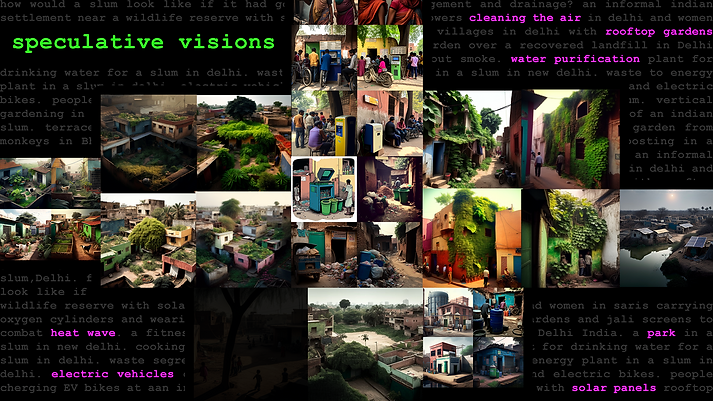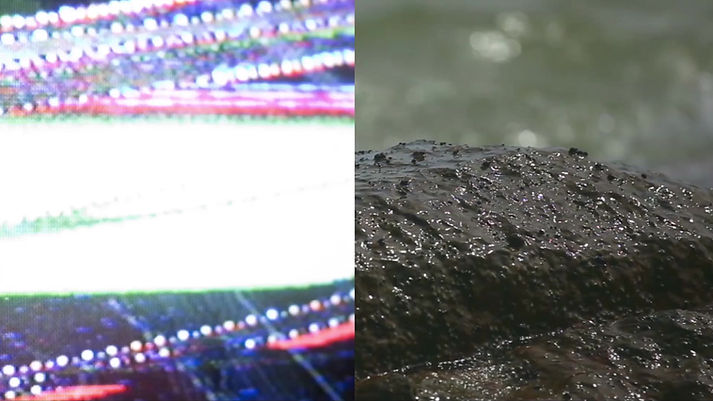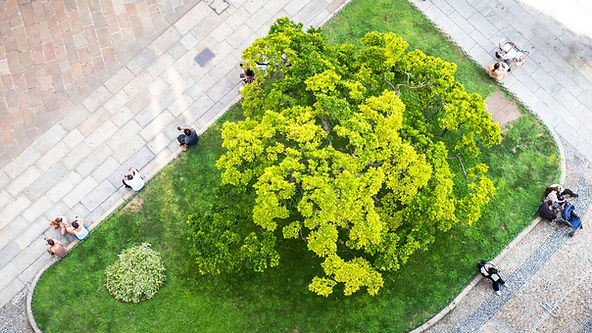
Speculative Visions
Research Project
Supported by:
-
Leeds 2023
-
British Council
-
Horizon's Institute & Cultural Institute, University of Leeds, UK
Team:
Artist: Kanchan Joneja (India)
Academic Researcher: Dr. Viktoria Spaiser (UK)
Community Partner: Lakshay Talwar (India)
The project ‘Speculative Visions’ combines art and AI as a participatory research and public engagement tool to facilitate grassroots-driven visioning of a climate-positive future with communities coming from underserved informal settlements in New Delhi, India. This unique, novel approach was tried in a pilot with 12 community members through a live session to explore the feasibility, potential and limitations of this approach. Ultimately the hope is to empower individuals coming from intersecting marginalised contexts to engage with and communicate their future visions.

Envisioning our Future
How marginalised communities in the Global South can use AI to envision a climate positive, resilient future for their city and neighbourhood.
Research has repeatedly suggested that positive visions about our societies’ futures are crucial for finding collaborative, fair solutions to the climate crisis. Collective visions give us energy to embrace challenges and guide us in taking crucial decisions. Visual images in particular provide means through which people can explore and understand their world and make sense of possible futures. Indeed, visuals can have a stronger impact on us than textual information – a picture can be worth a thousand words. And there have been some great examples of climate-positive future images produced to inspire our imagination.
 |  |  |
|---|---|---|
 |  |  |
 |  |  |
 |
The Delhi Pilot: Art and AI in Bhatti Mines
There are also great examples where artists worked with community members, including children to collaboratively generate such images. A good example is The Art of a Sustainable Future, an outreach project, conducted by the University of Leeds, in collaboration with the Leeds City Council, to imagine life in a zero-carbon future society, through collaborating with the public and school children.
However, most of the climate-positive images created so far, are biased towards the Global North, involving artists and communities from the Global North. Rarely are we asking the communities at the margins to share with us their ideas for a liveable future. And that is what we attempted with this small pilot, engaging inhabitants of the Sanjay Colony, Bhatti Mines in Delhi, India, to produce these future images.
Another innovation of our pilot is to utilise AI (DALL-E 2 and Midjourney) to generate such images in a live-interaction with these communities. The rationale for this is that AI is able to generate images based on people’s prompts immediately and without any intermediary, it also allows the community to iteratively refine their promps and hence iteratively improve the visual representatin of their future visions within a single, interactive, community-centered session. We started by talking to the community members (varying in age and gender) about climate change and local ecological problems and the social problems these create. The community members were encouraged to visualise these through drawings.
We also presented the communities with some examples for climate-positive future images across local, national and global level expressed through diverse visual styles and a mix of human and AI generated. Some of these were open source posters designed for climate change awareness from The Climate Collection as part of Artists for Climate by TED Countdown and Fine Acts.
We then used prompts from community members and fed them to the AI, which then immediately generated images. These were then instantly shown (using a projector) to the community for reflection, and they were able to refine their prompts to generate even better representations of their future vision in an iterative experiment.
As such, the AI tool can be an empowering tool for these communities to make collective sense of their images for a liveable future.
Below we show a selection of these generated images.

The Visual Representation
Interpretation, learnings, and continuing the exploration
The images show that people envision living in greener cities, with roof-top and façade-gardens, which would also provide crucial cooling during hot summer months. However, community members also noted that façade-gardens would invite snakes and roof-top gardens are prone to destruction from urban monkeys. When prompting the AI to come up with visual solutions for the monkey problem through appropriate fencing, the limitations of AI became quickly clear, as the AI struggled with these prompts and in the end no satisfying visual solution was found. The images also show the importance people attribute to solar panels for distributed energy production, including for charging electric vehicles (mostly in the form of three-wheeled rikshaws). Waste management, water management and air pollution are also featured prominently in the images.
It is also worth comparing these images of a positive climate-future envisioned by some of Delhi’s most deprived citizens with the images created in the Global North, including Leeds. What is striking is the desire of people, whether in Leeds or in Delhi, to be surrounded by lush gardens, trees, and plants, to integrate plant life within city buildings, to allow for nature to thrive within cities in a symbiosis. No one envisions a sterile environment with arrested life and nature. But this does not mean that technology is rejected, the prominence of solar panels is clear evidence for that. So maybe there is a common vision of a better future for all we share, despite the importance of the local context that presents people with very different challenges, requiring bespoke solutions.
We believe that this exercise in envisioning and imaging is not only useful for the community members to reflect on what they wish for the future of their children, but it can also provide a tool for better local political campaigning, to start a dialogue with the city administration on what the future of the city should be, what the long-term strategy for the city should be. And image-generating AI can be an empowering tool for these communities to communicate their concerns, solutions, and visions more vividly and more appealingly. The artist becomes in this process a key facilitator who understands humans and the machine to converse with the AI more effectively and also to design more creative visualisations that convey the message effectively. This was just a first, unique experiment, but we hope it will inspire similar projects and maybe bring us together in finding solutions to the climate and ecological crisis.

LEEDS 2023
For The Public Good
About the project
For The Public Good is an online international research project led by LEEDS 2023, The Horizon Institute, The Cultural Institute and is funded by the British Council.
5 international artists have been selected to be part of this project. Each artist is bringing with them a community member local to them who will inform the process. The 5 artists have been paired with 5 academics from the University of Leeds.
The aim of the project is to lay the groundwork of how art and technology can help your community combat climate change, through discourse and ideas generated from artistic creation and academic research.
The project will create international connections, share cultural learning and expertise, finding ways of sharing research about climate change through art and creativity. Academics and artists enter the experience on an equal footing and the agenda for their collaboration is set by both the artist and academic.






